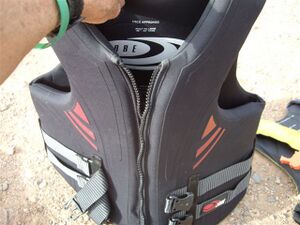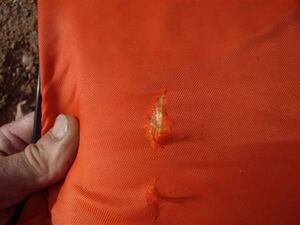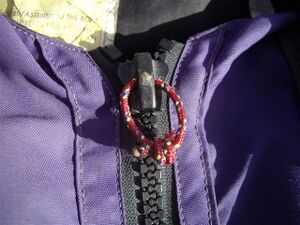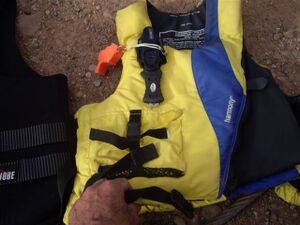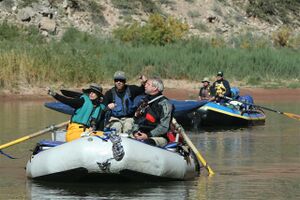Life Jackets
What about Life Jackets?
One of the most important aspects of river safety is your life jacket.
All life jackets, also called Personal Flotation Devices (PFDs), will be inspected by Grand Canyon National Park Rangers at the Lee’s Ferry put-in. Closely!
Before we go any farther, here are the Grand Canyon National Park regulations on life jackets from the Non-Commercial river trip regulations:
Emergency Equipment
A. Life Preservers and Regulations
Each participant MUST have a serviceable U.S. Coast Guard approved personal flotation device (PFD) Type I, III or V. One extra PFD must be carried for every 10 persons on the trip. These PFDs must be maintained in good and serviceable condition in compliance with the USCG standards AND MUST BE WORN AND FASTENED PROPERLY AT ALL TIMES WHILE ON THE RIVER. All PFDs must have a USCG approved label stating the PFD is designed for whitewater rafting, canoeing, sailing and/or kayaking. GENERAL BOATING OR SKI VESTS ARE PROHIBITED. The PFDs may not have any holes, rips, tears, broken buckets and/or broken zippers. A throw-able cushion (U.S. Coast Guard approved, Type IV) is required for each watercraft 16 feet in length and over.
On unsupported kayak or canoe trips, one extra PFD is required for every 4 kayaks and/or canoes. If there are fewer than 4 kayaks or canoes, one spare PFD is required.
Since the Lee's Ferry Rangers will be taking a close look at your PFD's, let's take a close look at the above regulations:
Only Type III or Type V lifejackets, with a United States Coast Guard (USCG) approved label stating the PFD is designed for whitewater rafting, canoeing, sailing and/or kayaking are allowed. GENERAL BOATING OR SKI VESTS ARE PROHIBITED.
Here is a typical Class III Ski Vest. This type of vest is NOT allowed!
If the label on your favorite life jacket says FLOTATION AID TYPE III PFD, that's great. But if the next line says INTENDED USE: SKI VEST, you need to leave this jacket at home.
Only PFD's without tears, without broken buckles, without broken zippers, and free of non-factory sewing, are allowed on your river trip.
Here is a typical TPYE III Whitewater PFD, that has developed a small tear. This vest is NO LONGER SERVICABLE! It will not pass inspection at Lee's Ferry. Period. By the way, only factory sewing is allowed on lifejackets.
Lee's Ferry Rangers will also reject attempts to replace a missing zipper pull with metal key rings, wire, etc. This is an especially common problem with YKK zippers on some PFD's. As recently as Sept '07, Rangers were allowing a fix consisting of a short piece of small-diameter cord looped thru the zipper and tied with a water knot. Here's a photo of someone's favorite life jacket with a busted pull repair. While this PFD "passed" inspection at Lee's Ferry, you might want to use this jacket only as a spare.
In this photo, a whistle has been attached to a TYPE III PFD. Rangers also object to the practice of fastening a whistle to the zipper pull with a cord longer than an inch or so. Again, they allow a short piece of cord, tied in a small loop. This is preferable to a longer 'lanyard' that could present an entanglement hazard. But, the added stress on the zipper pull is more apt to break the danged thing. Zippers lock without the proper pull, so it's an important item and difficult to fix on the river. Attach your whistle to another place on your jacket. This PFD did not pass muster, because it was a TYPE III PDF labeled INTENDED USE: BOATING VEST
Your PFD must be comfortably snug and work at all times when you are on a watercraft not tied to shore.
The shoulder straps of PFDs will be handy handles for the people in a raft attempting to rescue a person in the water. Loose PFDs have slipped off people in the water when the shoulder straps are used by rescuers, leaving the person in the water without a life jacket. Keep that PDF snug fitting around your body. See If you fall in the water… for more information.
Help others at Lee’s Ferry to adjust their PFD, and ask them to check and adjust yours.
Get in the habit of checking that everybody in your boat has their PFD on and done up whenever you set off from shore.
Once your jacket is fitted, try and get a swim in before hand in warmer water if possible. This is especially important if the jacket is new. Feeling comfortable in your life jacket is important because your PFD is the one thing that really is going to take care of you if you find yourself in the water without a watercraft at hand.
Also, those that are comfortable with it may have a rescue knife on their PFD. You should know how and when to use it if you pack one. Knifes have been used to cut entrapment straps, free bound oars, and cut free attachment lines in emergency situations.
PFD knives should not be used in the kitchen for breakfast, lunch and or dinner preparation unless they have been run through the dish washing system.
Click here to return to the River Safety page.
Click here to return to the Rivergear page.
photo credits Denis Stratford, Tom Martin
